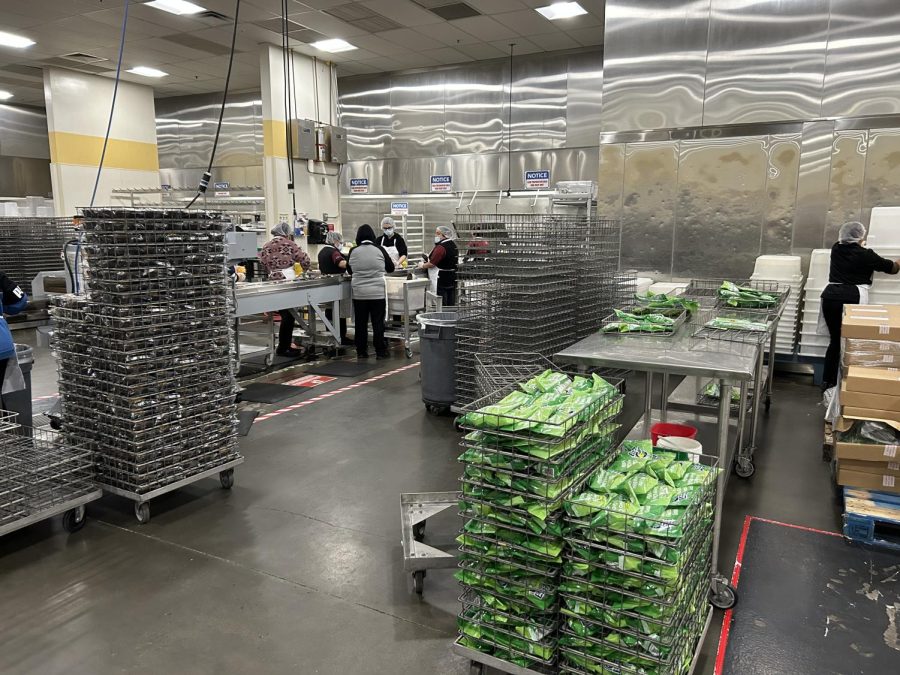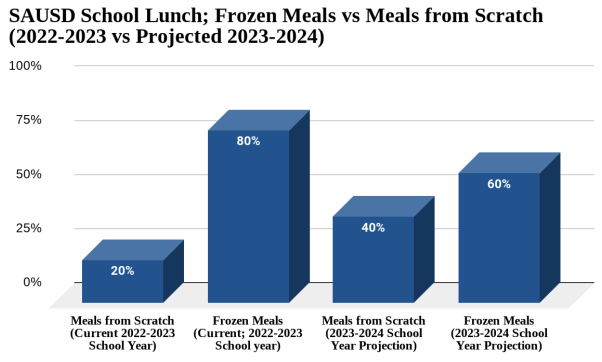The school lunch revolution
Image courtesy of Ethan Cardenas
The employees in the Central Kitchen work hard to provide students with their lunch for the day.
May 15, 2023
When students think of school lunch, frozen food is the first thing that probably comes to mind. This is the unfortunate reality of school lunch at the moment, with most food distributed at schools being frozen due to budget restraints on the school nutrition system. Although an uphill battle, the fight for change has begun to take shape. An example of this change can be found at Santa Ana Unified School District in Santa Ana, California. At the helm of the ship of change is SAUSD’s Nutrition Services, the organization tasked with providing and distributing school lunches.
In an attempt to encourage change, many students have often voiced their dissatisfaction with the food served to them at school, with many complaints being reared about the lack of variety. While the students’ voices may be considered a shot in the dark, they are often heard by district officials, who, with their vast team of dieticians and workers, seek to find new and innovative ways to change the menu. This process, however, can be challenging, as change is not as easy as students may perceive.
The Restraints
The budgetary restraints placed on the nutrition program stem from the categorical grants that have been set for schools to receive money for food. To receive money from the government, a school must first give out what they deem as a reimbursable meal, which consists of at least three servings of fruit, vegetables, dairy, grains, and proteins. Only after this meal is provided, will the district receive a subsidy to make up for the money spent on providing this meal to a student.
The state of California recently introduced a program known as California’s Universal Meals Program, intended to provide all California students with school lunches no matter their socioeconomic status. This has led to the overall deterioration of school lunches as schools are working with the same budget to provide more meals for students. Although SAUSD adopted this program earlier this year, other school districts have begun to charter SAUSD to create their lunches for them, causing SAUSD’s efforts to be spread thinly.
Despite these restraints, the Nutrition Services team headed by the Director of Nutrition Services, Josh Goddard, is working around the clock to change the currently stagnant system to a drastically different, revolutionary one. The central kitchen includes 87 workers, 50 of which, work long and hard to produce meals to feed SAUSD students daily.
Reducing Waste
While working within these restraints, the SAUSD team has managed to develop something known in the district as Meatless Wednesdays, where none of the options provided to students have any meat in them. While on the surface, this may seem like it was solely designed to be inclusive for students who don’t eat meat, it also reduces the amount of waste created by the school lunch system. During an interview with Goddard, he described its effect as “saving 44 million gallons of water and preventing the burning of 100,000 gallons of petroleum-based fuels.”
The district is also focusing on reducing food waste and has adopted a federal mandate now known as “Offer vs. Serve” (OVS), which allows students to decline some components of a reimbursable meal as a way of providing choice and reducing waste. “OVS is one of the best things we can do to reduce food waste,” he stated.
Goddard also provided some insight into other choices the district is making to reduce food waste. “We are working on a plan to connect leftover foods with local pantries and shelters so that unused foods do not go to waste. We have shared tables set up at every school cafeteria where students can leave unwanted items.”
Future Expectations
As of now, the state of school lunch is not the best or most appetizing for students, as most of the food comes frozen from distributors that partner with the district.
“This is the present, but here we are working on the future,” said Goddard. This future includes freshly cooked meals for SAUSD students directly produced at the central kitchen.
“As of now, we are currently looking to move toward a much nicer, new central kitchen to fulfill the rising amounts of food lunch we have to provide,” explained Mr. Goddard. The newly planned central kitchen, meant to be in a much more central location in the district, aims to facilitate the delivery of goods by cutting down on delivery time. In addition, the increased size compared to the current kitchen aims to solve another problem: providing tailored lunches for approximately eight-hundred students with allergies. At the new central kitchen, Mr. Goddard and his team seek to create rooms dedicated specifically to support the rigorous process required to fulfill allergy and texture requirements, such as labeling, cooking, and packaging, to avoid cross-contamination.
With high hopes for the new central kitchen, Nutrition Services seeks to expand its scope on school lunches by purchasing new equipment, such as rice cookers and large-scale heating pots from distributors such as Action Sales. Working on a quota system, Nutrition Services hopes to find the best prices for the best equipment. With these new developments, Goddard seeks to “revolutionize school lunch” by offering warm meals produced directly from the central kitchen in hopes of increasing variety and cutting down on frozen meals. He believes the future of school lunches is bright, with expectations to increase the production of meals from scratch by nearly doubling the amount.
SAUSD’s Nutrition Services is taking necessary steps that many other school districts across the nation are taking, yet many districts have yet to begin to address this need to modernize the school lunch system. If they follow some of the choices SAUSD has made and plan to make, they will be moving forward to revolutionize the school lunch system to provide appropriate, healthy choices for their students.



Desiree Soto • Dec 21, 2023 at 8:53 am
I love how you brought a whole new paradigm to school lunches and how our school district plans to combat budget restraints and waste from students!